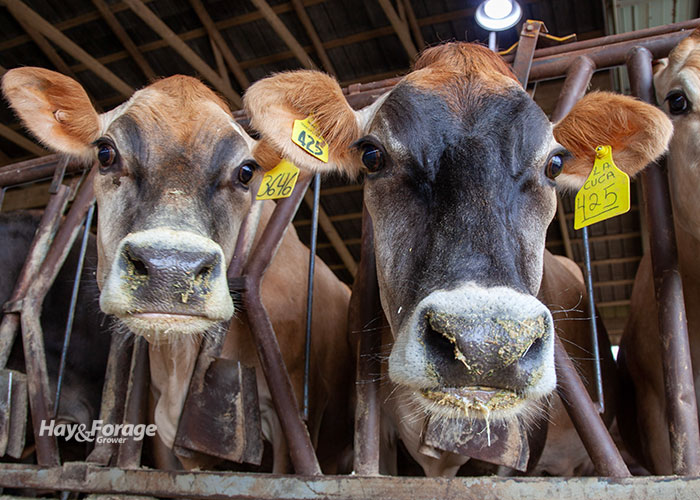Cud chewing provides a benefit: Here’s why |
| By Mike Rankin, Managing Editor |
|
|
 Cows were made to eat forage. We give them other stuff, but none of it comes under the entrée heading. Everything else is strictly a side dish. Built into this need for forage is the ruminant’s ability to chew its cud. According to Donna Amaral-Phillips, an extension dairy specialist with the University of Kentucky, dairy cows spend almost eight hours each day chewing their cuds. That’s a total of almost 30,000 chews daily. Cud chewing is the regurgitation of feed that has already been consumed and swallowed. The feed bolus is rechewed to an acceptable particle size and then reswallowed. “When cows chew their cuds, they secrete saliva,” Amaral-Phillips explains. “This saliva contains a natural antacid that helps buffer the rumen. Proper buffering of the rumen allows a cow to digest forages better and to eat more feed, which helps her produce more milk.” For optimal cud chewing and saliva production, forage particle length becomes an important consideration. Amaral-Phillips suggests that 15% to 20% of forage intake needs to be longer than 1.5 to 2 inches. Forages that are processed too short from chopping or mixing will result in less than sufficient cud chewing for adequate saliva production. On the flip side, too much long-cut forage will result in an excessive amount of time spent cud chewing, which reduces feed intake. “Cud chewing often can be used as an indicator of the health of a dairy herd,” Amaral-Phillips notes. “Cows that do not chew their cuds enough may have lowered milkfat tests, become lame, or have other digestive upsets such as twisted stomachs or displaced abomasums. All of these problems directly affect the profitability of a dairy operation,” she adds. The dairy scientist suggests the following recommendations to ensure cows get adequate effective fiber to stimulate cud chewing: 1. Feed high-quality forages, which stimulate cud chewing while also allowing for high feed intakes. Cows are ruminants and evolved to utilize forages, not grain, as their primary feed source. 2. Make sure that 15% to 20% of the forage is greater than 2 inches in length when a cow eats. In other words, 4 to 5 pounds of hay goes a long way in stimulating a cow to chew her cud. 3. Ensure the mixing wagon is not pulverizing the added forage. Mix just long enough to ensure a uniform ration. Check the total mixed ration (TMR) and compare the particle size against the original feed ingredient (hay, haylage, or corn silage). If the silage in the TMR mix is a lot smaller than the original forage, mixing time may be too long. If alfalfa hay is mixed in the TMR, add it last to minimize its mixing time. “The most important thing you can do is observe your cows,” Amaral-Phillips asserts. “Generally, we expect to see 60% to 70% of cows actually chewing their cuds when they are resting. Pay attention to fresh cows to see that they are chewing their cuds. Taking time to carefully observe your cows will pay dividends in recognizing potential problems before they become major headaches,” she concludes. |
